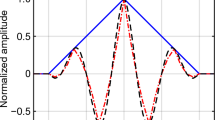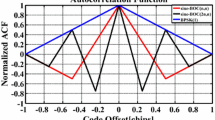Abstract
Modern Global Navigation Satellite System including Galileo and GPS III will employ multiplexed binary offset carrier (MBOC) modulation to achieve spectrum separation and enhanced tracking performance. A challenge of the MBOC or BOC signal tracking is the presence of ambiguities due to multiple sidepeaks of the autocorrelation functions. Several different techniques including multi-correlator and double estimator schemes have been proposed to address the ambiguity issue. We propose a class of ambiguity-free code tracking techniques by exploiting the unique features of the BOC modulation. In the proposed architecture, the incoming BOC-modulated signals are correlated with BOC-modulated replica and the spreading codes, respectively. Through a multiplicative combination strategy of the two correlator outputs, a noncoherent weighted discriminator is formed and shown to possess the ambiguity-free property. The multipath effect is assessed and compared with existing early-minus-late power and autocorrelation sidepeak cancellation technique discriminators. The noise effects of the theory and simulation are also discussed. In order to further verify the proposed scheme, a set of field data of a Galileo in-orbit validation satellite is collected and processed. It is demonstrated that the proposed method is simple to implement, free from ambiguities, and yields acceptable performance in the presence of multipath and noise.















Similar content being viewed by others
References
Avila-Rodriguez JA, Hein GW, et al (2008) The MBOC modulation: the final touch to the Galileo frequency and signal plan. Navigation: J Inst Navigat 55(1):14–28
Betz JW (2001) Binary offset carrier modulations for radionavigation. Navigation: J Inst Navigat 48(4):227–246
Betz JW, Kolodziejski KR (2000) Extended theory of early-late code tracking for a bandlimited GPS receiver. Navigation: J Inst Navigat 47(3):211–226
Borre K, Akos DM et al (2007) A software-defined GPS and Galileo receiver—a single frequency approach. Birkhäuser, Boston
Dovis F, Mulassano P, Lo Presti L (2005) A novel algorithm for the code tracking of BOC(n, n) modulated signals. In: Proceedings of the 18th international technical meeting of the satellite division of the institute of navigation. Long Beach, CA, USA
Hein GW, Avila-Rodriguez JA, et al (2006) MBOC: the new optimized spreading modulation recommended for GALILEO L1 OS and GPS L1C. In: Proceedings of the IEEE/ION position, location, and navigation symposium
Heiries V, Roviras D, et al (2004) Analysis of non ambiguous BOC signal acquisition performance. In: Proceedings of the 17th international technical meeting of the satellite division of the institute of navigation, Long Beach, CA
Hodgart MS, Blunt PD, et al (2008) Double estimator—a new receiver principle for tracking BOC signals. Inside GNSS, pp 26–36
Holmes JK (1999) Code Tracking loop performance including the effects of channel filtering and gaussian interference. Proceedings of the IAIN world congress in association with the ION annual meeting, San Diego, CA
Holmes JK (2007) Spread spectrum systems for GNSS and wireless communications. Artech House, Boston, USA
Juang JC (2008) Multi-objective approach in GNSS code discriminator design. IEEE Trans Aerospace Electron Syst 44(2):481–492
Juang JC, Chen YH et al (2010) Design and implementation of an adaptive code discriminator in a DSP FPGA-based Galileo receiver. GPS Solut 14(3):255–266
Julien O (2005) Design of Galileo L1F receiver tracking loops. Ph. D. Dissertation, Department of Geomatics Engineering, University of Calgary
Julien O, Macabiau C et al (2007) ASPeCT: unambiguous Sine-BOC(n, n) acquisition/tracking technique for navigation applications. IEEE Trans Aerospace Electron Syst 43(1):150–162
Kao TL, Chen YH, et al (2007) A DSP/FPGA design for the acquisition and tracking of GIOVE-A signals. In: Proceedings of the 20th international technical meeting of the satellite division of the institute of navigation, Fort Worth, TX
Kaplan ED, Hegarty CJ (2006) Understanding GPS: principle and application, 2nd edn. Artech House, Boston, pp 227–229
Martin N, Leblond V, et al (2003) BOC(x,y) signal acquisition techniques and performances. In: Proceedings of the 16th international technical meeting of the satellite division of the institute of navigation, Portland, OR
Meyr H, Ascheid G (1990) Synchronization in digital communications phase-, frequency-locked loops, and amplitude control. Wiley, New York, vol 1
Wu J, Rizos C, Dempster AG (2008) Effect of pre-correlation filter on BOC-Gated-PRN discriminator. In: The 9th international conference on signal processing (ICSP 2008), Beijing
Acknowledgments
This work has been supported by the National Science Council, Taiwan under contract NSC 98-2221-E-006-194-MY3.
Author information
Authors and Affiliations
Corresponding author
Appendix: Derivation of the tracking error variance
Appendix: Derivation of the tracking error variance
The appendix derives the tracking error variance of the code tracking loop in the presence of additive Gaussian noise. The derivation is similar to the procedure adopted in (Holmes 1999; Holmes 2007; Julien 2005). Neglecting the multipath term, after substituting (5), (6), (10), and (11) into (24), the weighted discriminator can be expressed as
In evaluating the tracking error variance, it can be assumed, without loss of generality, that \( \phi_{0} \approx 0 \). Thus, the weighted discriminator can be rewritten as
For convenience, the expression (34) is expressed as
where
From (Julien 2005), the tracking error variance is given by
where \( K_{{y_{\text{weighted}} }} \) is the loop gain associated with the weighted discriminator, and \( \sigma_{{{\text{y}}_{\text{weighted}} }} \) is the discriminator output standard deviation. The loop gain can be computed as
Note that the correlation function of \( \Uplambda ( \cdot ) \) is symmetric, that is,
Thus, the gain can be simplified as
where \( \Uplambda^{'} \left( { - \frac{d}{2}T_{c} } \right) = \left. {\frac{{{\text{d}}\Uplambda \left( {\delta - \frac{d}{2}T_{c} } \right)}}{{{\text{d}}\delta }}} \right|_{\delta = 0} \) and \( \Uplambda^{'} \left( {\frac{d}{2}T_{c} } \right) = \left. {\frac{{{\text{d}}\Uplambda \left( {\delta + \frac{d}{2}T_{c} } \right)}}{{{\text{d}}\delta }}} \right|_{\delta = 0} \). Substituting (8) into (41) and after some manipulations, the slope can be shown to be equal to
From (35), the variance of weighted discriminator can be expressed as
The variance of \( N_{1} \) is given by
Let \( A_{1} = w_{1} v_{{I_{W1} }} \left( t \right) + w_{2} v_{{I_{W2} }} \left( t \right) \) and \( A_{2} = v_{{I_{B1} }} \left( t \right) - v_{{I_{B2} }} \left( t \right) \). Because the Q components are identically distributed and independent from the I components, the terms in (44) can be calculated as
Assuming that the code delay error is small, \( N_{2} \) can be reduced to
Owing to (40), \( N_{2} \) can be simplified as:
In a similar way, the variance of \( N_{2} \) can be expressed as:
The results of \( E\left\{ {A_{1} A_{2} } \right\} \), \( E\left\{ {A_{1}^{2} } \right\} \), and \( E\left\{ {A_{2}^{2} } \right\} \) can be derived by using the spectral characteristic of the input signal/noise. The covariance at each correlator can be expressed as:
where
In the above, \( S_{c} ( \cdot ) \) is the power spectral density of the PRN waveform which is given by \( S_{c} (f) = T_{c} {\text{sinc}}^{2} \left( {\pi fT_{c} } \right) \).
The covariance between \( N_{1} \) and \( N_{2} \) is zero since the product of \( N_{1} \) and \( N_{2} \) leads to a polynomial with monomials of odd order in zero mean Gaussian random variables. Then,
After some calculations, (44) and (49) can be, respectively, written as:
and
Using (56), (57), and (58), the variance of the weighted discriminator output can be expressed as:
Assuming a front-end filter with unity gain within \( \pm {{B_{w} } \mathord{\left/ {\vphantom {{B_{w} } 2}} \right. \kern-\nulldelimiterspace} 2} \) Hz, and substituting (42) and (59) into (38), the code tracking error variance is obtained.
where
Rights and permissions
About this article
Cite this article
Kao, TL., Juang, JC. Weighted discriminators for GNSS BOC signal tracking. GPS Solut 16, 339–351 (2012). https://doi.org/10.1007/s10291-011-0235-7
Received:
Accepted:
Published:
Issue Date:
DOI: https://doi.org/10.1007/s10291-011-0235-7




